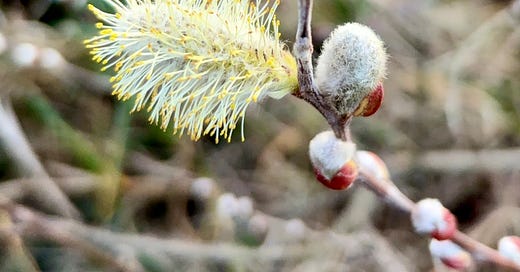It’s early evening in early spring and so a lot colder than the sun would have you think. But there’s the warming sight of a calm sea – neatly rumpled in shades of pale blue and pink, like an old lady’s bedspread.
I walk these cliffs often. They are, I suppose, my patch. But thinking of it like that brings a pressure I’m not comfortable under. A pressure that I should know them like I know the way to my bathroom in the dark.
I know that the sun sets there, then there, then there. I know the washed-out greens and greys of winter turn to 4K ultra HD greens and golds in spring. I know where the fulmars nest and when there’s a new abandoned bag of dog poo. I know where the skylarks sing and when there’s new tyre tracks left by dirt bikes.
But just as I sometimes stub a toe when going to my bathroom in the dark, there are things on these cliffs that trip me up. Plants, usually. Plants can be complicated.
I know the gorse and the thrift and the bracken, and even the early purple orchids that grow on a grassy slope. But I don’t know this large clump of dry, bare twigs dotted with dark red pimples and tufty bobbins.
I learn that it might be rusty willow. Or maybe grey willow. But probably pussy willow.
Rusty Willow sounds more like the name of a children’s TV presenter than a plant I’d find out here. Grey Willow is her more serious older brother who writes 1,000-page literary fiction about London art dealers. And Pussy Willow … well … they don’t talk about her …
If asked – by whom and when, I don’t know – I would have said pussy willow was a plant all of its own. And it is most commonly used as an alternative name for goat willow. But it’s also a pseudonym for grey willow. And it can be used to describe several other willows when their catkins (or tufty bobbins) appear at this time of year.
Depending on what you read, rusty and grey willow are either one and the same or subtly different subspecies that are distinguishable only by the colour of tiny hairs on the underside of their leaves. The leaves don’t appear until after the catkins have gone. And the hairs are only really visible with a magnifying glass.
See, complicated.
I can, though, be sure that this clump of willow is a male clump of willow. Some of those dark red pimples have become early-stage fluffy grey catkins. The more advanced have sprouted dozens of yellow-tipped matchsticks, ready for the wind to carry their pollen to nearby female catkins, which are green and longer than the male version.
But whether I should call this clump of willow rusty or grey is as up in the air as the pollen. And, honestly, I’m fine with this patch of my patch remaining something of a mystery. For me, it’s enough to just think: “Oh, look at those tufty bobbins.”
Basking sharks seen on this walk: 0
Total basking sharks seen to date: 0





"Tufty bobbins"... I think it may catch on?!
I had a similar struggle identifying the willow at the end of our garden. Fluffy catkins, probably goat willow, but tall for a goat willow. A tall old goat willow. The “tufty bobbins” shower down on our garden furniture once they are done.